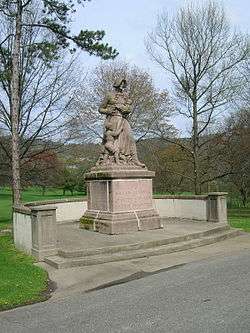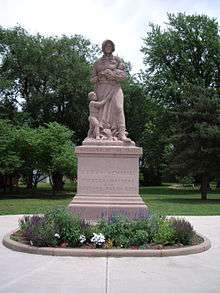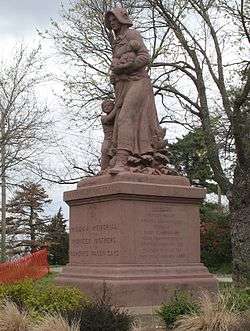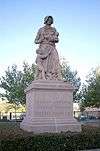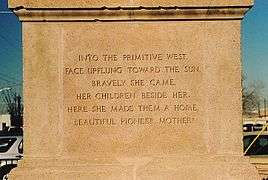Madonna of the Trail
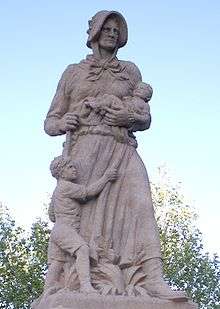
Madonna of the Trail is a series of 12 identical monuments dedicated to the spirit of pioneer women in the United States. The monuments were commissioned by the National Society of Daughters of the American Revolution (NSDAR). They were installed in each of the 12 states along the National Old Trails Road, which extended from Cumberland, Maryland, to Upland, California.
Created by sculptor August Leimbach and funded by contributions, the Madonna of the Trail monuments were intended to provide a symbol of the courage and faith of the women whose strength and love aided so greatly in conquering the wilderness and establishing permanent homes. Dedicated in 1928 and 1929, the twelve statues became sources of local pride. Through the continuing efforts of local and national groups, all are currently in good condition and on display.
History
In 1911, the National Society Daughters of the American Revolution (NSDAR) established a national committee known as the National Old Trails Road Committee. It worked to establish the Old Trails Road as a great National Memorial Highway. In 1912 the National Old Trails Road Association was organized, and the roadway became known as the National Old Trails Road. The group wanted to recognize the contributions of women with a statue to be erected in each of the twelve states connected by the road. The committee chair, Judge (and future U.S. president) Harry S. Truman, guaranteed the expense of the erection of the monuments. A design was completed in 1927.
- "They [the women] were just as brave or braver than their men because, in many cases, they went with sad hearts and trembling bodies. They went, however, and endured every hardship that befalls a pioneer." Harry S. Truman at the Ohio dedication ceremony
Truman, at that time the President of the National Old Trails Association, attended the dedication in Albuquerque, New Mexico, on September 27, 1928, of its statue. This monument was re-dedicated 44 years later on September 27, 1972.
Design and specifications
Arlene B. Nichols Moss, chairwoman of the DAR Committee, envisioned a statue similar to one she had seen in Portland, Oregon by the Denver sculptor Alice Cooper. Sacajawea and Jean-Baptiste (1905), located in Washington Park, features Sacagawea, the Shoshone Native American woman who helped guide Meriwether Lewis and William Clark on their search for a water route to the Pacific Ocean. An acquaintance recommended the sculptor August Leimbach of St. Louis, Missouri. He created the design which was finally approved by Moss and cast the twelve monuments. As executed, the statue bears little to no resemblance to Cooper's Sacagawea.
In the Summer 1928 issue of The Federal Illustrator Magazine, Leimbach described his work. "The monument, 'The Madonna of the Trail' was modeled for art-stone (granite) and done in a time less than a month, to be placed in 12 states, from Maryland to California as a trail marker on the old National Trails.
"The idea I had, when I modeled the design was this: The pioneer mother with her children was waiting for the father at their blockhouse in the wild West, for the father did not come home as he had promised. She, believing him to be in danger, put her little child in a blanket, grasped the gun and with the boy ran out in the field to look for the father.
"The gun is sketched from the gun of Daniel Boone, with his carvings on the shaft. On the ground is prairie grass and cactus brushes, also arrowheads, and on one side in the shadows, there is visible in the original, a rattlesnake, partly covered by grass.
"When I was a schoolboy in the old country, the American History of the pioneer days made a deep impression on me. I thought often of those who had left the old home and all that was dear to them and had come to this country to find a field for their ambition.
"When I came to America, I often saw these people of the pioneer type, strong and brave and always ready to protect themselves against any danger. Asked to make a sketch model for a monument of a woman of pioneer days, I was inspired by my own impression of these people I had met, and the Madonna of the Trail is the result."
The statues feature a pioneer woman clasping a baby with her left arm while clutching a rifle with her right. Her young son clings to her skirts. The figure stands ten feet high and weighs five tons. The figure and the base are made of algonite stone (a poured mass) of which Missouri granite is used as the main aggregate. The monument has a warm, pink shade. With the base, the monuments are about 18 feet (5.5 m) high. The inscriptions on the east and west sides of each base are the same, but the north and south sides of each monument usually include local information as well.
Locations
There is one monument in each of the 12 states along the National Old Trails Highway (much of which later became U.S. Highway 40 and U.S. Highway 66).[1] The monuments in order of dedication are:
As of 2005, all 12 monuments are still available for public viewing, although several have been relocated short distances due to highway improvements, etc. Many have been refurbished and re-dedicated since the 1970s. Community groups in each state are watchful for the conditions and security of each Madonna monument.
Officials of Cumberland, Maryland, tried to have the Maryland Madonna of the Trail monument moved to their city, which is at the beginning of the National Road, but Bethesda declined the request.
Positioning
- Due to the positions on the sites, Maryland's Madonna on Wisconsin Avenue in Bethesda has long been the only one facing east. In December 2004, the statue had to be temporarily removed to repair a foundation problem. An alert reporter for the Washington Post noted that as it was placed on the flatbed truck, the Madonna faced west, believed to be the first time all 12 have done so.[5] The reporter was mistaken, as the statue in Upland, California faces south, not west.
- The Madonna monument in Upland, California stands on historic Euclid Ave. and faces South. The Springerville, AZ Madonna faces north.
- A longstanding joke about Maryland's Madonna was that she was placed facing east because no sensible American woman would think it a good idea to turn her back on Washington, D.C.
- Springfield's Madonna was recently relocated to the new National Road Commons park located in downtown Springfield, Ohio. The statue is positioned facing south for better visibility on Main Street (Route 40).
Images
Further reading
- Bauer, Fern Ioula (1984). The Historic Treasure Chest of the Madonna of the Trail Monuments. Springfield, Ohio: J. McEnaney Print.
ASIN: B0006EG8TM
See also
References
- ↑ Kirby, Doug (12 May 2006). "Mother Roads: A guide to U.S. mom-uments". NBC News. Retrieved 13 November 2017.
- ↑ http://www.wvculture.org/history/monuments/madonnaofthetrails01.html
- ↑ Sanders, Jeffrey C. (2004). McClellan Park: The Life and Death of an Urban Green Space. Albuquerque: The Albuquerque Museum.
- ↑ Steinberg, David (June 26, 1998). "Spirit of pioneer women lives on". Albuquerque Journal. Retrieved May 18, 2018.
- ↑ News article - "Listing Madonna Rescued in Bethesda"


